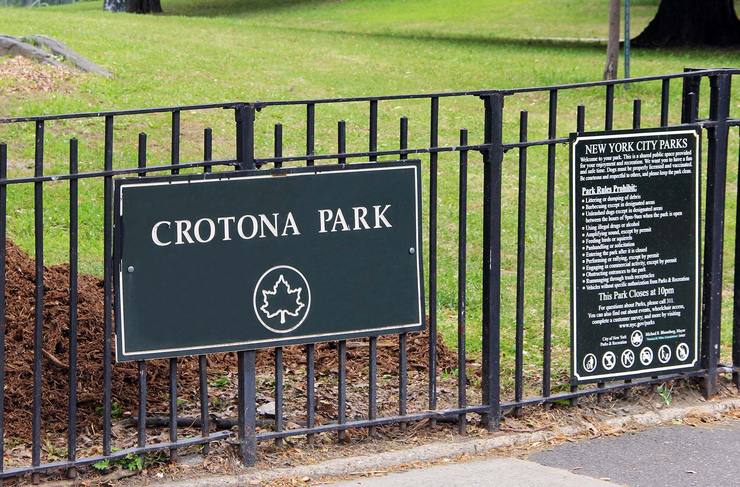
Here is the Department of Parks press release for Friday, June 27, 1941:
The Department of Parks announces the completion and opening of seven new marginal playgrounds, three reconstructed playgrounds, a children's farm garden and two comfort stations in Crotona Park, The Bronx. These playgrounds represent part of a larger program of park reconstruction which will be completed this fall.Crotona Park is one of the most heavily used parks in the City. Prior to the start of rehabilitation work the pressure of a congested neighborhood had overflowed play areas onto the park lawns, injuring the vegetation, causing erosion and miniature dust storms thus destroying the usefulness of the area.
The first major effort to provide much needed recreation facilities and restore the scenic values of the park was the construction of a swiming pool in 1936 together with the rehabilitation of the adjoining unit of park land lying between Fulton and Crotona Avenues. In the following years two new playgrounds were laid out along Crotona Park East and various other minor improvements were made.
Plans for the present project, embracing the complete reconstruction of the remaining sections of the park were prepared early in 1940 by the Department of Parks and the work was started shortly thereafter by the Work Projects Administration. The main features of this work include the following items:
- Ten additional marginal playgrounds
- Reconstruction of the children's farm gardens
- Four baseball diamonds with concrete bleachers
- One softball diamond with concrete bleacher
- Construction of a wall around the lake
- A boat house and concession building on the lakeside
- Thirteen double handball courts
- Reconstruction of athletic field on Crotona Park North
- Demolition of many outworn paths and roadways and construction of a complete new path system with curbs, asphaltic pavement, steps, ramps, benches, lights, fencing, etc.
- General reconstruction of the park storm drainage system
- Landscaping of the entire park including new topsoil and planting of 2800 new trees, 18,000 shrubs and lawns.
- Realignment of the south end of Orotona Avenue within the park, for better traffic circulation.
The only section of the park which remains untouched by the current operations is the area along Third Avenue to the north of East 175 Street, This section contains the old Borough Hall which should be demolished. Repeated requests to the Board of Estimate for assignment of this to the Park Department have been refused.
The reconstruction of Crotona Park represents a major effort in the park improvement field and when completed its results will be increasingly appreciated as the new plant growth becomes established and the various recreational facilities attain their full use.
All work was performed by the Work Projects Administration from plans prepared by the Department of Parks. In 1934 there were 119 playgrounds in the five boroughs, 58 of these have been reconstructed. At present there are 425 playgrounds in the park system.
As noted above all of this was in addition to the work done between 1934 and the opening date, most notably:
- Ten new tennis courts [May 1, 1934, Press Release]
- Swimming pool, wading pool, diving pool, and bathhouse. During the off-season the bathhouse serves as a gymnasium. In freezing weather the pools are ice-skating rinks and at other times serve for paddle tennis, shuffleboard, volleyball, basketball, and handball. [June 24, 1936, Press Release]
- Another playground, for a total of 12;
- A roller-skating track;
- 24 handball courts, 12 horseshoe courts, 4 Bocci courts
The addition of these new play facilities represents the completion of a program, started in 1936 with the construction of the swimming pool. The work involved the entire reconstruction of this old 150 acre neighborhood park, one of the most heavily used play centers in the City. Prior to the reconstruction project the outmoded and rundown recreation areas were inadequate to satisfy the excessive requirements of a congested neighborhood which resulted in the destruction of adjacent lawns and vegetation.
The stone amphitheater and bridges at Indian Pond are not WPA projects, even if they look like they should be; they were added in 2009.
[Dept of Parks Crotona Park Page] [Dept of Parks Crotona Park History] [Crotona Park Bathgate Playground]
Tremont Park
When the Cross-Bronx Expressway was built in 1948-1972, Crotona Park was split into two parks. The larger piece south of the Expressway is still called Crotona Park; the smaller piece to its north is now called Tremont Park. This explains why in some places, Crotona Park is said to have 155 acres, and in others only 127. Even though its name changed (twice), Tremont Park was indeed a WPA project. It was still called Crotona park until 1987, then it was Highland Park until 1999, now it's Tremont Park. It covers 15 acres.[Dept of Parks Tremont Park History]
|
The New Deal in
NYC 1932-1943 |
Frank da Cruz |
fdc@columbia.edu
|